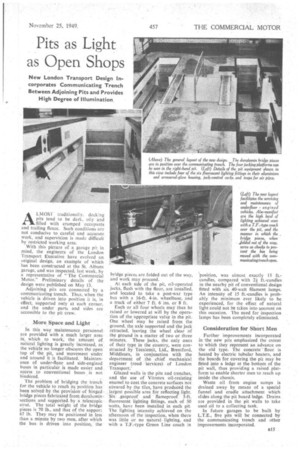Pits as Light as Open Shops
Page 49

Page 51

If you've noticed an error in this article please click here to report it so we can fix it.
ALMOS I traditionally. docking pits tend to be dark, oily and filled with cramped occupants and trailing flexes. Such conditions are not conducive to careful and accurate work, and supervision is made difficult by restricted working area.
With this picture of a garage pit in mind, the engineers of the London Transport Executive have evolved an original design, an example of which has been constructed at the St. Albans garage, and was inspected, last week, by a representative of The Commercial Motor." Preliminary details of the design were published on May 13.
Adjoining pits are connected by a communicating trench. Thus, when the vehicle is driven into position it is, in effect, supported only at each corner. and the under parts and sides are accessible to the pit crew.
More Space and Light _
In this way maintenance personnel are provided with a much larger area in which to work, the amount of natural lighting is greatly increased, as the vehicle no longer obscures the open top of the pit, and movement under and around it is facilitated, Maintenance of under-floor and side-engined buses in particular is made easier and access to conventional buses . is not hindered. .
The problem of bridging the trench for the vehicle to reach its position has been solved-by the provision of hinged , bridge pieces fabricated from duralurnin sections and supported. by a telescopic strut. The total weight of the bridge pieces is 70 lb., and that of the support 67 lb. They may be positioned in less than a minute by two men, after which the bus is driven into position, the bridge pieces are folded out of the way, and work may proceed.
At each side of the pit, oil-operated jacks, flush with the floor, are installed, and located to take a post-war type bus with a 16-ft. 4-in, wheelbase, and a track of either 7 ft. 6 ins. or 8 ft.
Each or all four wheels may thus be raised or lowered at will by the operation of the appropriate valvx in the pit. One wheel may be raised from the ground, the axle supported and the jack retracted, leaving the wheel clear of the ground in a matter of two or three minutes. Thesejacks, the only ones of their type in the country, were constructed by Tecalemit, Ltd., Brentford, Middlesex, in conjunction with the department of the chief mechanical engineer (road -services) of London Transport.'
Glazed walls in the pits and trenches, and the use of Vitretex oil-resisting enamel to coat the concrete surfaces not covered by the tiles, have produced the largest possible area for reflecting light. Six .gasproof and flameproof. 3-ft. fluorescent lighting fittings, each of 30 watts, have been installed in each pit. The lighting intensity achieved on the afternoon of the inspection, when there was little or no naturallighting, and with a T.F.-type Green Line coach in
'position, was almost exactly 15 ft.candles, compared with 2+ ft.-candles in the nearby pit of conventional design fitted with six 40-watt filament lamps. An intensity of 15 ft.-candles is probably the minimum ever likely to be experienced, for the effect of natural light could not be taken into account on this occasion. The need for inspection lamps has been completely eliminated.
Consideration for Short Men Further improvements incorporated in -the new pits emphasized the extent to which they represent an advance on the old type. The concrete floor is heated by electric tubular heaters, and the boards for covering the pit may be fitted into a ledge at the bottom of the pit wall, thus providing a raised platform to enable shorter men to reach up inside the chassis.
Waste oil from engine sumps is drained away by means of a special funnel and cradle attachment which slides along the pit board ledge. Drains are provided in the pit walls to take used oil to a collecting tank.
In future garages to be built by L.T.E., five pits will be connected by the communicating trench and other improvements incorporated. of these hostels are good, but before now I've gone back on the road after two hours in bed, because the livestock seemed to think it was meal time when I climbed in with them.
"Stretching a point may save a day, or an uncomfortable night, and there will be no sleep lost in the long run. I fit in with the boss all right and he leaves it to me. If I say no' he takes it as being reasonable. I don't want a Government job and to be a unit. I've driven all sorts of vehicles and all sorts of loads, and I know what I can do. I know what's safe and what isn't."
I asked about pay.
"I earn more than a lot of drivers, and I've saved. I used to be a fitter and I lend a hand in that way some willing to cede that power to the cclossus.
in the meantime, money _is being wasted because drivers on urgent jobs often stop for the night several hours short of the optimum distance, knowing that to reach the next hostel or rest place offering reasonable accommodation would mean an hour lost in terms of earning capacity.
A more extensive system of approved hostels on the pattern of the best existing establishments is needed. The B.T.C. has probably considered this necessity With a troubled conscience and an eye to expenditure. The drivers themselves would be suspicious of any move to stipulate stopping places, State-con




















































































